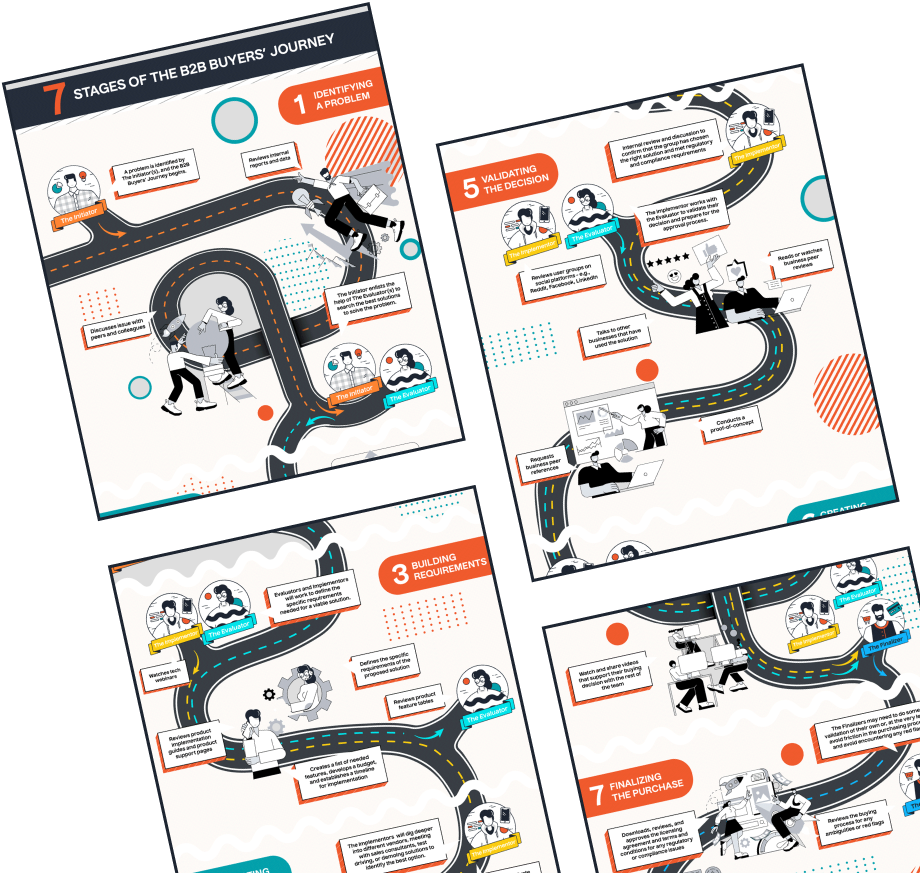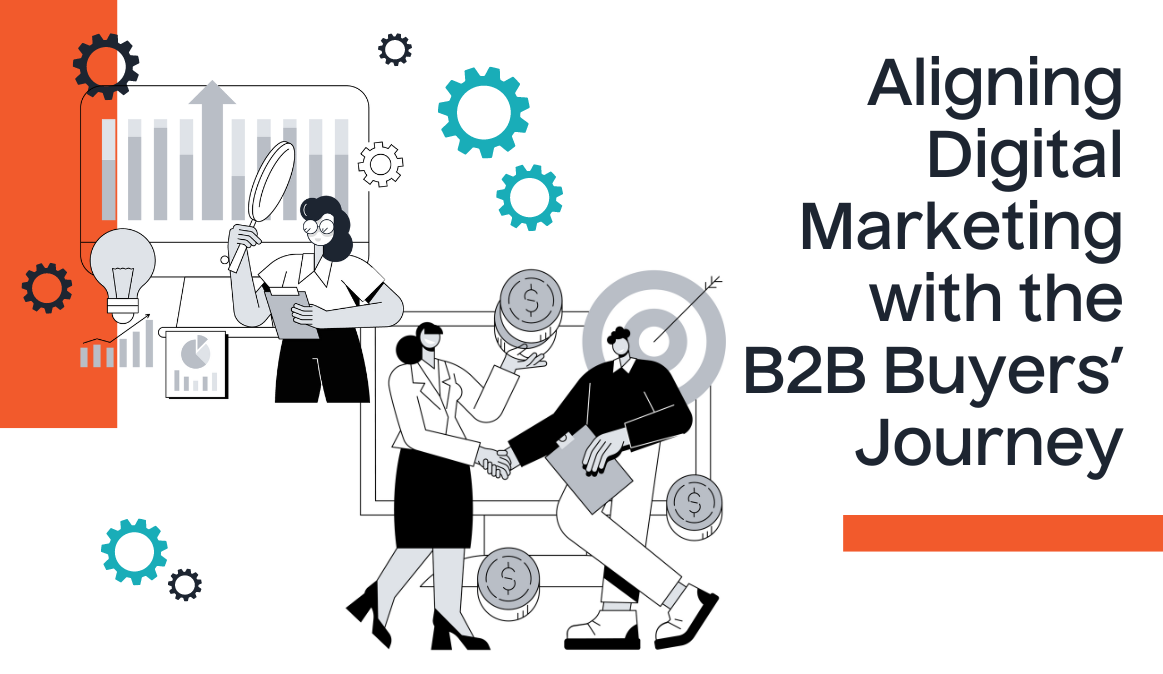
Master the B2B Buyer’s Journey: Align Your Digital Marketing Strategy to Unlock Revenue
Understanding the more significant dynamics of a B2B Buyer’s Group is critical to the success of your digital marketing efforts.
The business-to-business (B2B) buyer’s journey is long and complex, involving multiple decision-makers, stages, objectives, and touchpoints. Unlike buyer-to-consumer (B2C) selling situations where an individual makes a purchase decision, when a large organization evaluates and purchases a new product or service, in a B2B setting, different stakeholders, evaluators, and decision-makers are involved in various stages of the buying process.
According to a survey by Gartner of 750 B2B buyers, 77% said their latest purchase was “very complex or difficult.” Yet many B2B sales and marketing organizations still think of “the buyer’s journey” concept as a singular buyer and a linear funnel.
The B2B buyers’ journey is an adventure in group dynamics and is anything but linear.
B2B Buyers’ Groups often consist of up to 6 to 10 evaluators and decision-makers. Each contributor to the buying process may gather information independently and prioritize features and benefits based on their role within the organization.
The 4 Key Players in the B2B Buyers Group

A buyer group consists of individuals with distinct roles or personas who may enter different phases of the buyer’s journey through different channels. Some may participate in only one phase, while others may be involved in all stages. The four most common B2B buyer roles or personas are initiators, evaluators, implementors, and finalizers.
1. Initiators
These are project or program Initiators, such as line-of-business (LOB) leaders. These key stakeholders often seek out new products or solutions to achieve an organizational goal, solve a problem, or remove a roadblock to the business’s success. Business leaders may be interested in new revenue streams, improving customer experience, increasing operational efficiencies, preventing threats, and future-proofing infrastructure. B2B buying journey initiators aren’t likely to search for software solutions directly. They may choose to evaluate solutions recommended by colleagues or their peers or assign the task to their team members.
2. Evaluators
Product or solutions Evaluators bridge the gap between business value and functional requirements. Solution architects and systems designers often assume the evaluator role in a technical B2B buyers’ journey. These Evaluators look for better ways to design systems or new solutions that satisfy their requirements or provide business advantages. They may look for examples of different ways to design systems architectures or software solutions that meet the needs of their project parameters or better achieve the business goals.
The roles most commonly associated with Evaluators are architects, system analysts, or engineering department heads, although this depends on the industry. An Evaluator could also be a senior project manager, producer, or program manager.
3. Implementors
Implementors are often developers, engineers, and hands-on users who test-drive proposed products or solutions. Given the technical nature of their position within the organization, Implementors may absorb a wide variety of content based on their level of expertise and their phase within the buyers’ journey. They may be in research mode, seeking to learn about core concepts, or in active development mode, looking for docs, code samples, or help from the community. Implementors often look for ways to make their jobs easier, biasing towards the easiest or fastest ways to get up and running.
4. Finalizers
Almost every B2B organization has a purchasing process that may include requirements that need to be met based on regulatory compliance, environmental considerations, strategic sourcing, or other business objectives. Finalizers may be the procurement director, the project procurement manager, or the Chief Procurement Officer – whoever is responsible for ensuring their requirements are met. These are the dot the i and cross the t folks that may require additional documentation that can make or break a B2B sale. Finalizers may also be the person in the C-suite with final approval of the B2B buyers group’s recommendation.
The Seven Critical Activities the B2B Buyers Group Completes
Although complex and often varying by industry, typically, the group effort of a B2B Buyers’ Journey can be broken down into a set of B2B buying stages and activities. We’ve added to Gartner’s list of six B2B buying jobs and identified a seventh important but often overlooked activity:
- Identifying a problem: Someone or a subset of the buyers’ group, the Initiators, realize they have a problem within their organization to solve.
- Exploring a solution: The Initiators and Evaluators research solutions and reach out to peers, colleagues, and former colleagues to find solutions to their identified problem(s).
- Building requirements: The Evaluators and Implementors will work to define the specific requirements needed for a viable solution.
- Selecting a supplier: The Evaluators will investigate different vendors, meet with sales consultants, and test or demo solutions to identify the best option.
- Validating the selected supplier: Internal review and discussion to confirm that the group has chosen the right solution and met regulatory and compliance requirements.
- Creating consensus: Implementors will work to get everyone—Initiators, Evaluators, and Finalizers—on board with their decision.
- Taking action—finalizing the purchase: The Finalizers will complete the contract review and budget approval process and confirm that any remaining compliance or other business issues are resolved and that the purchase is approved.
Aligning Your Digital Marketing Efforts to Each Stage of the B2B Buyers’ Journey
To align digital marketing with the B2B buyer’s journey, marketing teams must create content and experiences relevant to each stage of the journey and each buyer persona. Understanding the activities and pain points at each stage and the role within the organization undertaking the activity can help you align your marketing methods and messaging and ultimately achieve better results.
However, be aware that B2B buying teams are diverse, with no consistent order in these stages. Multiple buying team members may be responsible for multiple activities in the buying journey. Likewise, tasks related to the buying process at each stage can be undertaken individually or concurrently. So maintaining a focus on what activities a buying team will need to do to complete buyers’ journey and how your marketing materials can help them complete each stage is an intelligent approach.
Identifying the Problem
At the problem identification stage, buyers realize they have a problem to solve. Which buyers on the B2B team are kicking off the buying process by addressing a problem? As mentioned above, these are typically The Initiator, a department head, LOB leader, or someone at the VP or C-suite level. They may not know the problem or the solution precisely, but they know that something must be done.
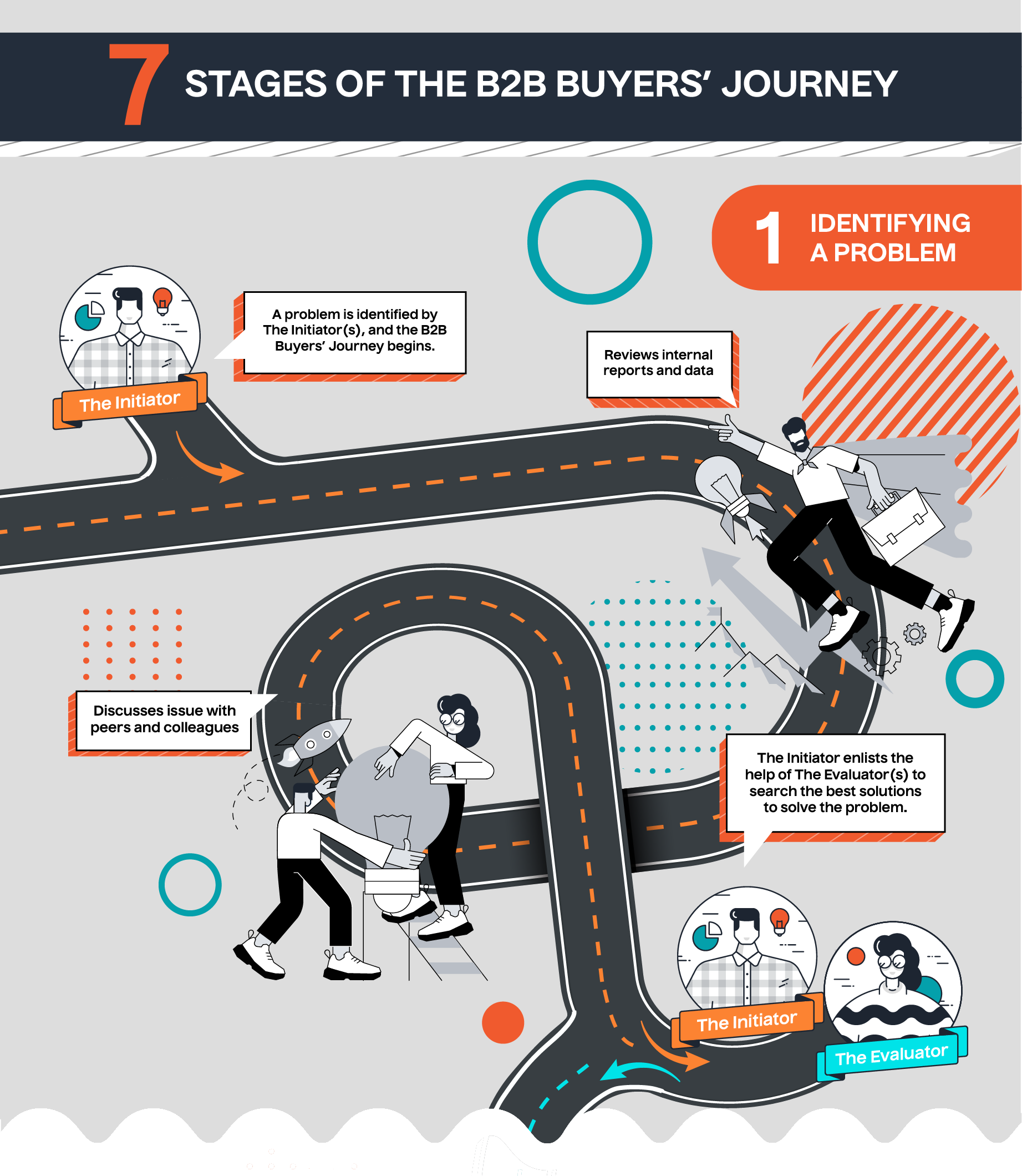
Marketing Materials to Create for Identifying the Problem
Help these Initiators better understand the problem they are facing and the context within similar businesses and the broader industry by creating content specifically for the problem identification stage:
- How-to video content: Create videos outlining common customer problems and how your product or solution solves them. Include how to turn on or implement the most beneficial tools and features.
- Explainer video: Use video to explain the most commonly asked questions about your product or service.
- Article (blog) content: Write and publish articles on your website about everyday problems in your industry. For example, if you sell CRM software, you could write articles about the challenges that sales teams face or the benefits of implementing a CRM system.
- White papers: Write about your industry’s latest trends and challenges. This type of content can help buyers understand the context of their problem and its potential impact on their business.
- Case studies or Customer Success Stories: Write case studies about how your solution has helped other businesses solve similar problems. This type of content can help buyers see how your solution works and build trust in your company.
Marketing Channels to Target Problem Identifiers
Keep in mind that this problem-identification stage is where the informational search for problems and solutions begins. So review our article on An Informational Search Intent SEO Strategy: Start with Video.
Beyond SEO, awareness campaigns should be considered for targeted audiences on social platforms and paid search ads.
Exploring Solutions
Once the Initiators on the buying team have identified the problem, they begin to work with other team members to explore potential solutions. This group of Evaluators may read reviews, compare different products and services, and talk to other businesses that have faced similar problems.
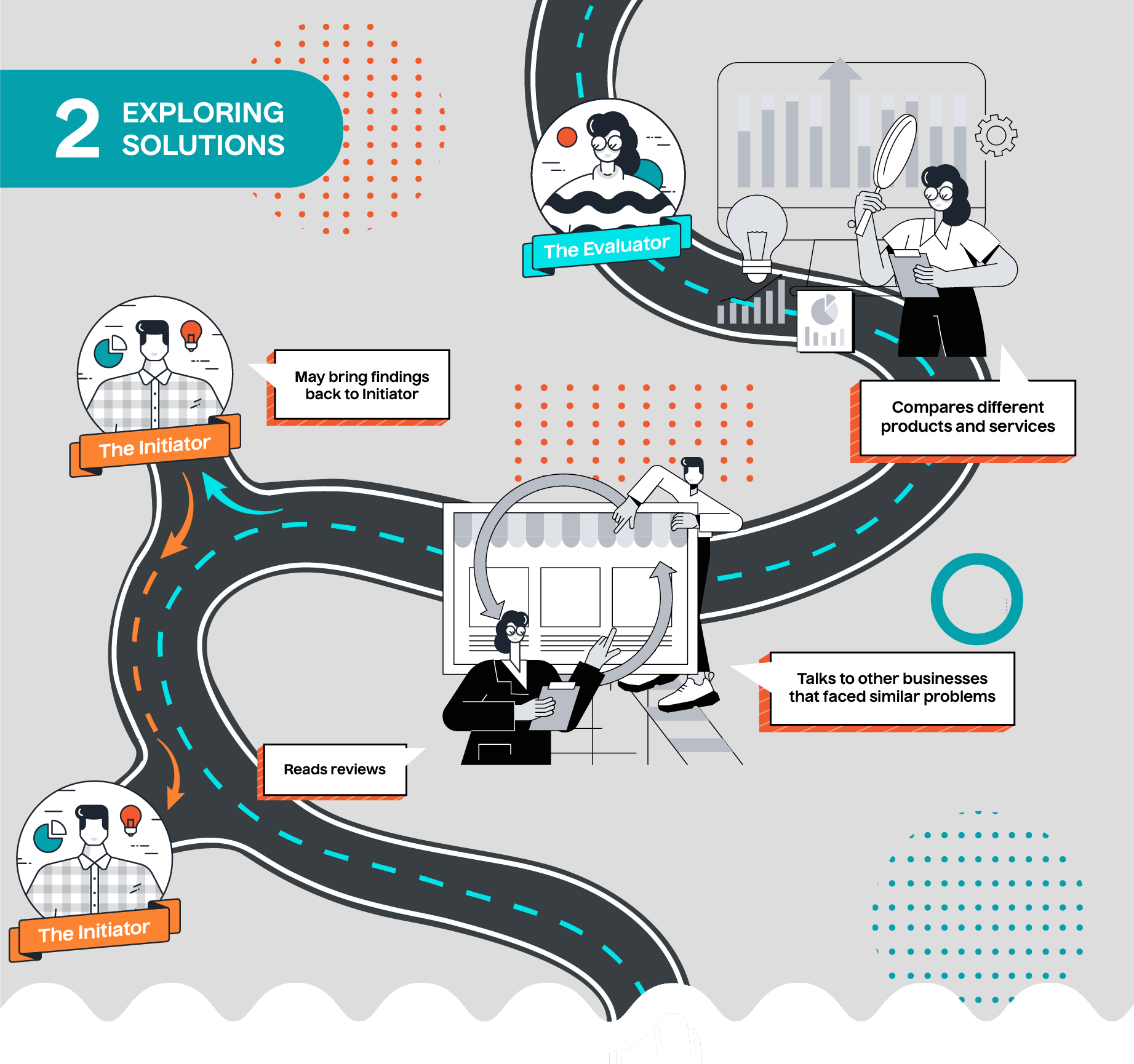
Marketing Assets to Create for Exploring Solutions
Create content and experiences to assist the Evaluators in moving through the solution exploration stage:
- Product pages: Create product pages that showcase your solution and its features. Make it easy for buyers to learn about your solution and how it can help them solve their problems.
- Product demo videos: Create videos demonstrating your solution’s features and benefits, such as ease of implementation, most common uses, reporting, notifications, etc.
- Comparison guides: Create comparison guides that compare your solution to other solutions on the market. This type of content can help buyers make an informed decision about which solution is right for them.
- Customer testimonials: Collect and publish customer testimonials from businesses that have used your solution to solve their problems. This type of content can help buyers to build trust in your company and to see how your solution has worked for other businesses.
- Customer success story videos: Like testimonials, but in a video format, interview your best customer advocates and educate potential buyers at this stage about how your solution specifically helped a similar business.
Marketing Channels for Solutions Exploration
Don’t ignore your website as a marketing channel; be sure your newly created solutions and exploration content are discoverable on your website. Beyond that, consider paid promotions on social media, particularly LinkedIn, to target those roles within your target industries and companies that would most likely be looking to solve those identified problems and searching for solutions like yours.
Building Requirements
Once the Evaluators on the buying team have explored potential solutions, they begin to work with or become the Implementors to define the proposed solution’s specific requirements better. They may create a list of needed features, develop a budget, and establish a timeline for implementation.
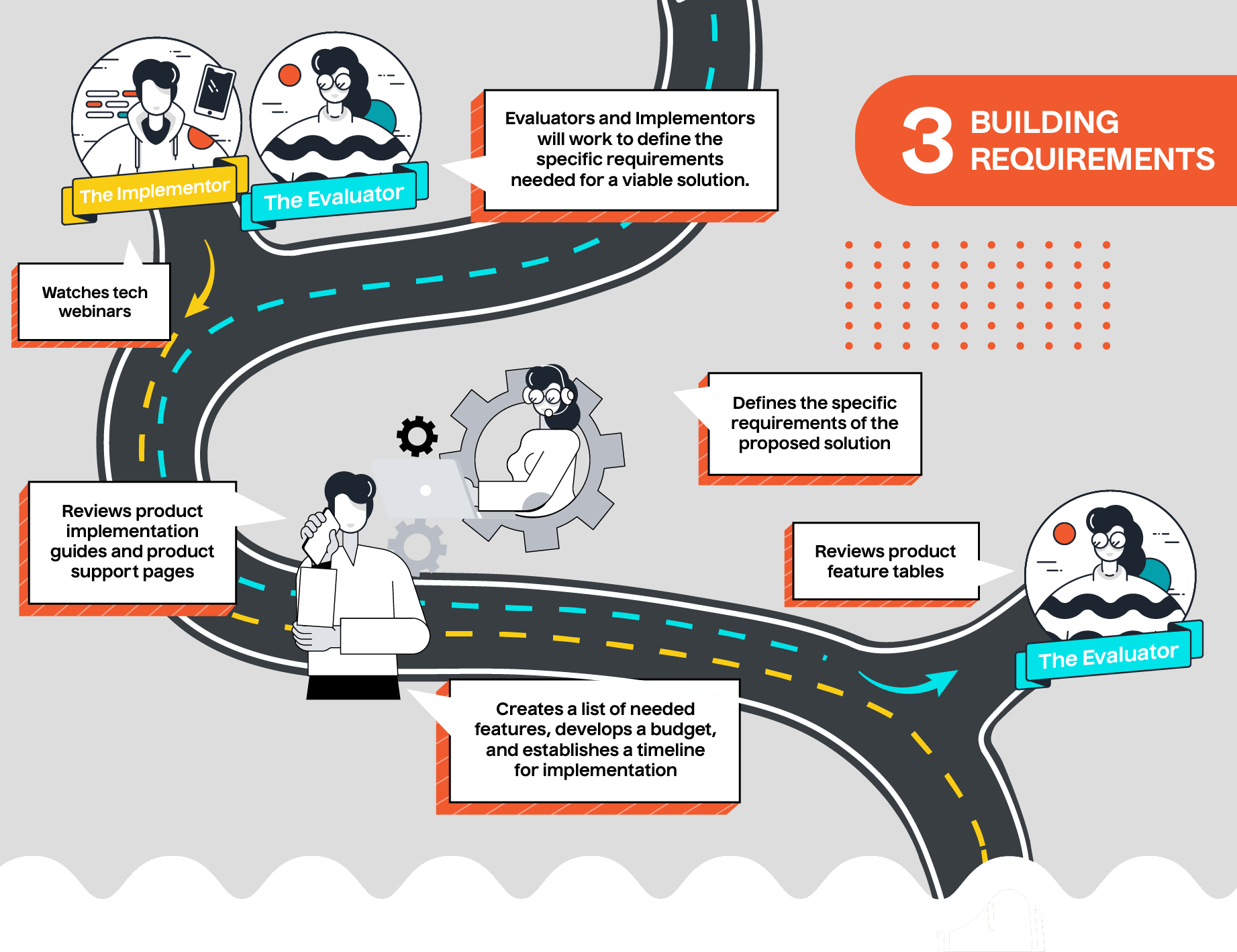
At the Building Requirements stage, the B2B Buyer’s Group evaluates whether your product meets their needs and fits into their implementation plan.
Marketing Assets for the Building Requirements Stage
Content and experiences to help Implementors complete the requirements-building stage:
- Targeted Webinars: Whether targeting developers or other Implementors, host watch-and-learn or other tech webinars about your product or solution.
- Business requirements gathering templates or worksheets: Create business requirements gathering templates or worksheets that buyers can use to define their requirements. This content can help buyers organize their thoughts and ensure they don’t miss anything important.
- Product feature tables: Create product feature tables that make it easy for buyers to see which features your solution offers and how it meets their requirements.
- Product implementation guides: Organized by industry, these types of how-to guides can help those responsible for implementing the new solution determine how easy or problematic that process will be.
- Support page topics: Common regulatory or implementation issues should be well documented in the Product Support section of your website and easily discoverable in your site search. Remember, evaluators and implementors will also evaluate the support level they may or may not receive.
Marketing Channels for Addressing Building Requirements Needs
This third stage is an excellent time to turn up your retargeting efforts on social channels and paid search. If Initiators or Evaluators have engaged with your content during the earlier problem identification and solutions exploration stages, retarget them with content that addresses the need to build requirements. But remember that the B2B journey is not linear! That means you can experiment with retargeting to surface other content in other stages.
Additionally, it’s time to be intentional with your remarketing efforts. Create a remarketing email campaign if you’ve captured leads through your marketing efforts at the problem identification or solutions exploration stage. Feature the content types mentioned above to help those B2B buyers’ team members move through the requirements-building stage quickly and efficiently.
Selecting the Supplier
Once the B2B buying team’s implementors have defined their requirements, they begin evaluating different vendors and selecting the best one. At this stage, the implementors may collaborate with the Evaluators or certain Initiators may be looped back in. Regardless, those team members narrowing down the selection are likely to want to test-drive your solution and make a final comparison of prices, features, and customer support.
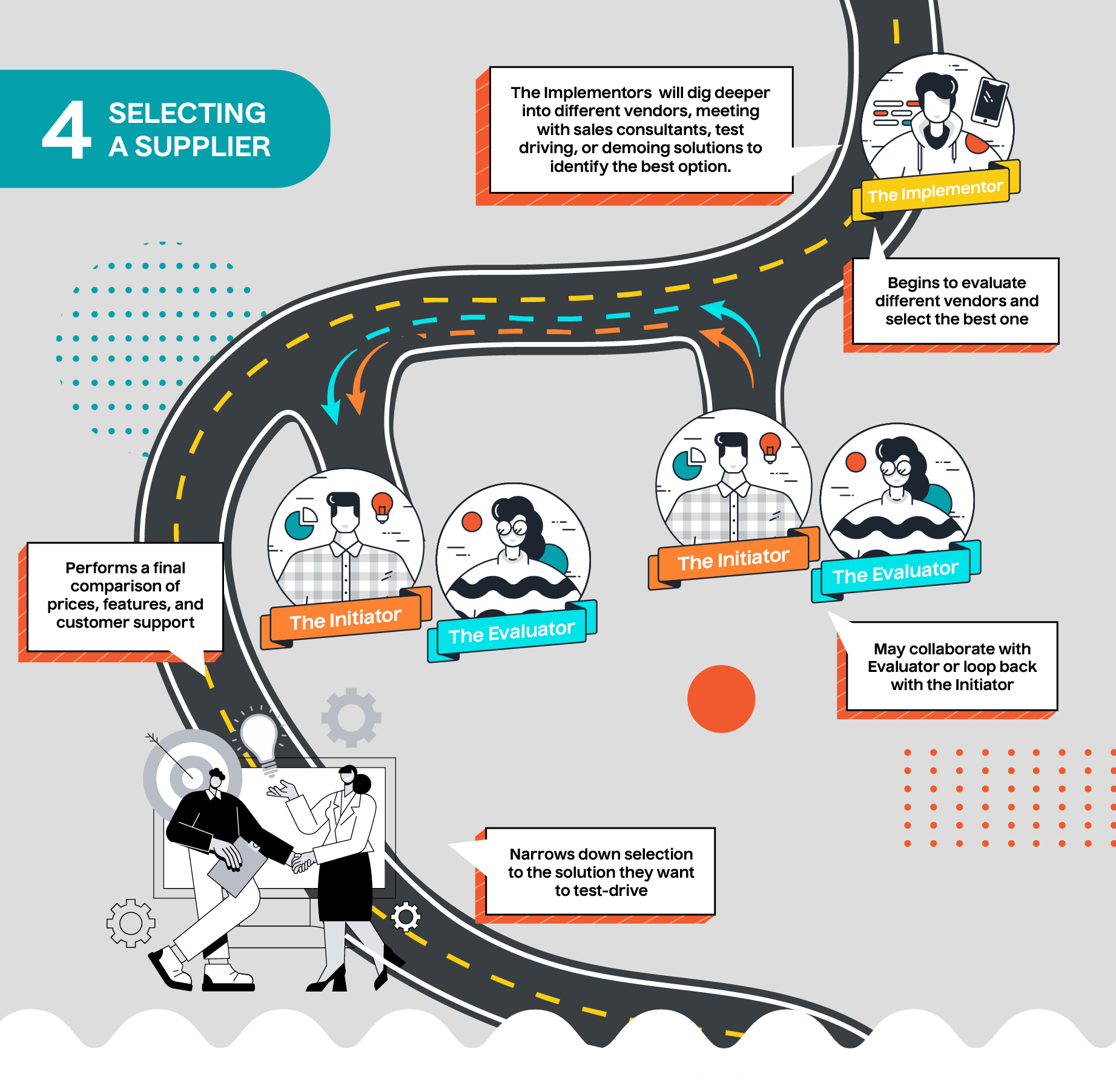
In the Selecting a Supplier stage, key decision-makers collaborate to narrow down their selection by test-driving solutions and comparing vendors on crucial factors like price and implementation.
Marketing Materials to Help with Supplier Selection
Digital marketing offers to satisfy the supplier selection team:
- Simulators: Create simulators that allow buyers to try out your solution before they buy it. This type of content can help buyers to get a better understanding of how your solution works and to make sure that it meets their needs.
- Personalized or 1:1 demos: Offer personalized demos of your solution to buyers or the ability to schedule a 1:1 guided demo. This type of content allows buyers to see how your solution can be customized to meet their needs.
- Free trials: Offer buyers free trials of your solution. This type of offer allows buyers to test-drive your solution before they commit to buying it.
- Effective landing page for SEM and SEO: Since this stage is most likely to generate leads and conversions, create a targeted landing page that features your offer and is optimized for organic and paid traffic conversions. Read our article, How to Create Effective Landing Pages for SEM and SEO, and use our downloadable template.
Marketing Channels for the Supplier Selection Stage
Your website will be the critical channel to convert visitors at this stage but drive traffic from organic and paid social channels. Also, look to SEO and paid search to target specific keywords and phrases related to this buyers’ journey activity. Your potential customers will likely be specifically searching for demos and free trials at this stage. Make sure you show up prominently in search results when they do!
Validating the Decision
Once the buying team, led by The Evaluators and Implementors, has selected a vendor, they must validate their decision and prepare for approval. They may do this by:
- Reading or watching customer reviews
- Reviewing user groups on social platforms – e.g., Reddit, Facebook, LinkedIn
- Talking to other businesses that have used the solution
- Requesting customer references
- Conducting a proof-of-concept
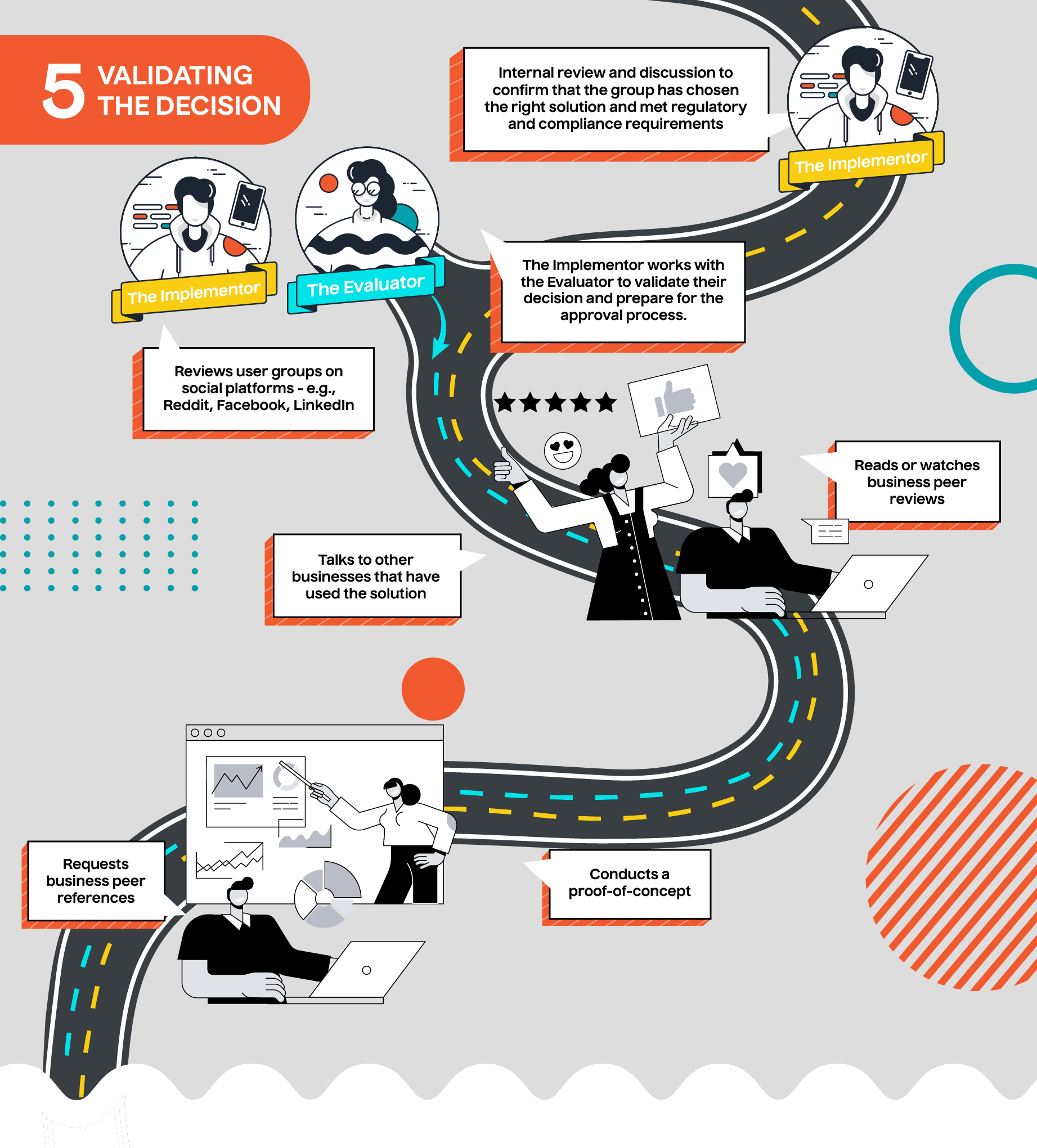
Validating the Decision involves gathering business references, conducting proof-of-concept trials, and collaborating to ensure the selected solution meets all requirements.
Marketing Assets to Help Validate
Create these additional digital marketing deliverables for the validation stage:
- Press Releases and News: Feature your best third-party reviews and positive news mentions prominently in the articles section of your website. Include them in your email campaigns to your leads.
- Case studies: Publish case studies that show how your solution has helped other businesses to achieve their goals.
- Benchmarks: Provide benchmarks that show how your solution compares to other solutions on the market.
- References: Offer references from customers willing to talk about their experiences with your solution.
- Tailored email campaigns: If a B2B buyer team member has accepted any offers in the Supplier Selection stage by submitting their email address, this is the opportunity to create automated, targeted email campaigns to help them validate. These emails surface your best reviews, success stories, case studies, benchmarks, and references. A thoughtful email marketing campaign will help guide your potential buyers through the validation process and make it easy for them to move on to the next stage.
Marketing Channels for the Validation Stage
At this stage, remarketing, email campaigns, and retargeting on social channels like LinkedIn should be a heavy focus. For SEO, pay particular attention to the types of search intent performed at this stage by team members looking to validate, and be sure to develop an intent-based SEO content plan for your website.
Creating Consensus
Once the Evaluators and Implementors have validated their decision, they need to get everyone else on the B2B buying team on board. They may need to go back to present to The Initiator or convince stakeholders, other decision-makers within the organization, and even end-users.
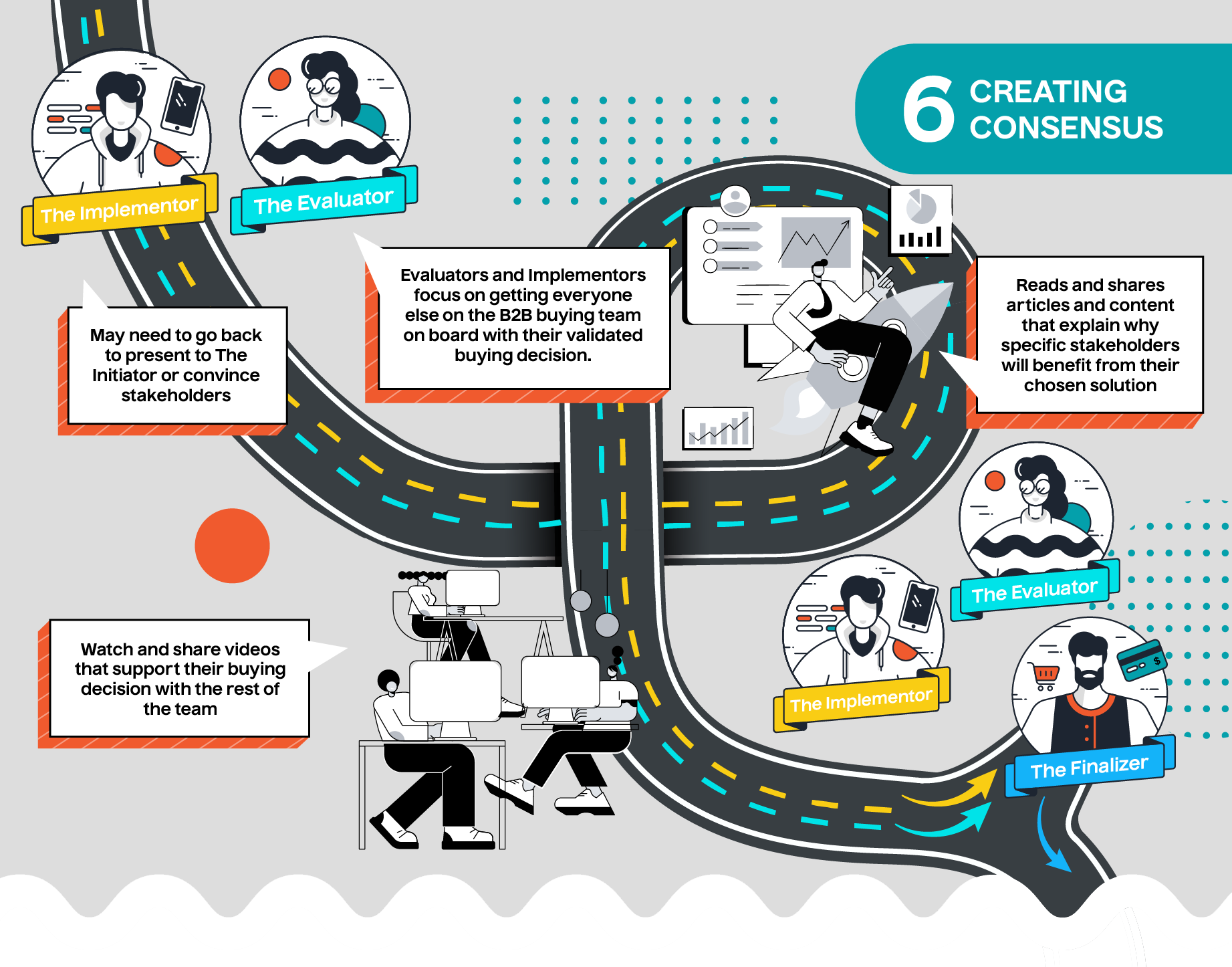
During this phase, evaluators and implementors work together to present the solution and ensure the entire team supports the buying decision.
Marketing Materials for Creating Consensus
Create content and experiences explicitly geared toward creating consensus by developing:
- Why [persona] loves us content: Create content that specifically addresses the needs and concerns of each buyer persona. In the case of B2B buying, this may be “Why the CMO Loves Us,” “Why the Engineering Team Loves Us,” or “Why Customer Service Professionals Love Us.” This type of content can help B2B buyers in different roles understand how your solution can benefit them and build trust in your company and solution.
- Customer experience videos: Create videos of customers talking about their experiences with your solution and how it helped them achieve their goals. Videos can be a powerful way to build trust and credibility.
- ROI calculators: Create ROI calculators that help buyers estimate the return on investment that they can expect from your solution. This content can help buyers justify your solution’s purchase to their stakeholders.
Marketing Channels to Help Achieve Consensus
In terms of paid channels, LinkedIn may be your best bet to target those companies, industries, and roles and surface your consensus-creating content types listed above as promoted content. Additionally, targeted email campaigns to those leads generated in previous buyers’ journey stages will provide the best return on investment.
Taking Action: Finalizing the Purchase
Consensus is great, but someone has to take out their corporate credit card or sign a purchasing agreement. These Finalizers may need to validate their own or, at the very least, avoid friction in the purchasing process and not encounter any red flags.
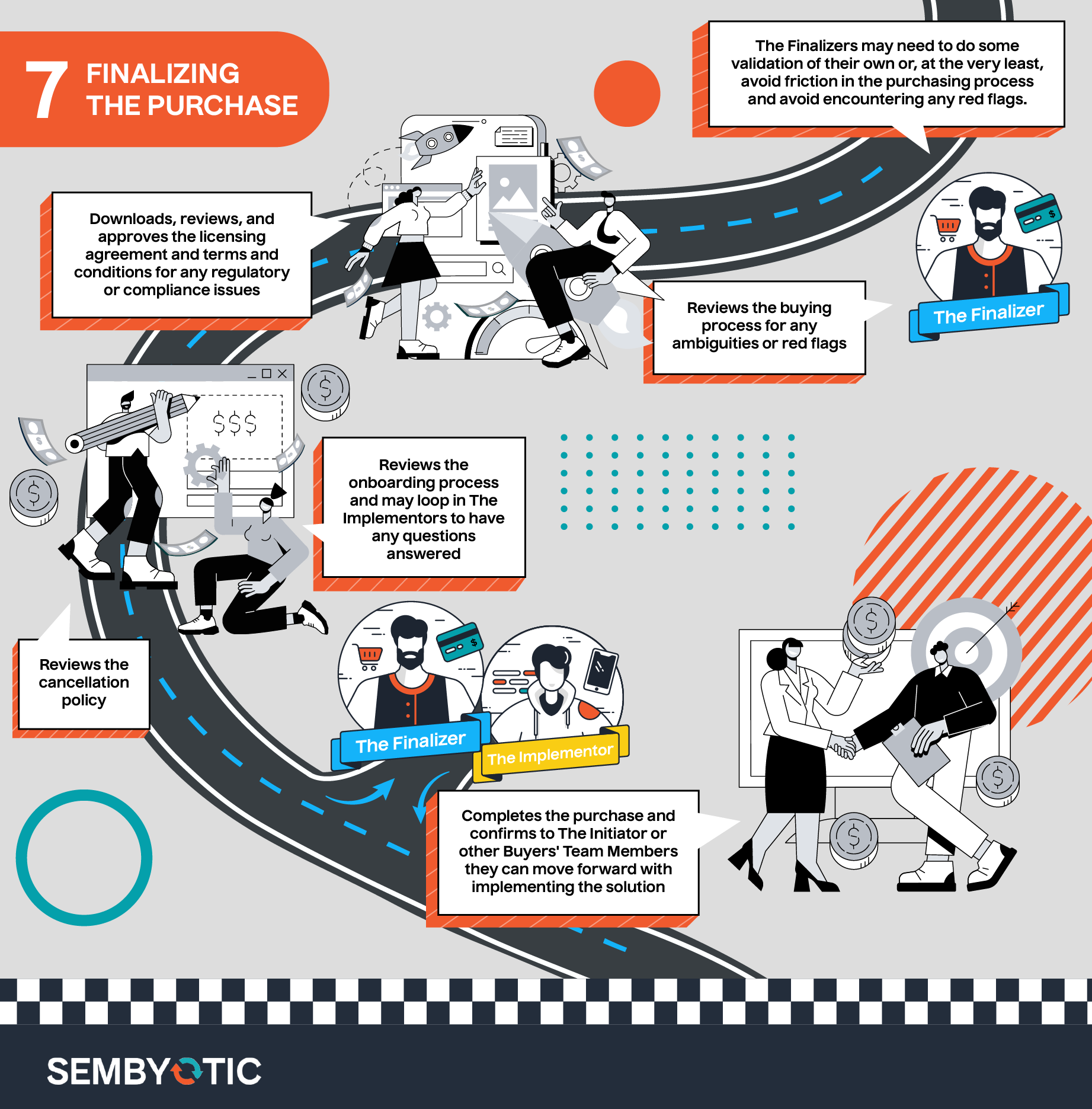
What does this mean as a digital marketer? You’ll need to evaluate your buy flow and any web pages these Finalizers may encounter. Create a buying experience that is easy and friction-free by creating:
- An easy “Buy Now” process: The call to action to complete a purchase should be easy to spot and complete. Be sure to meet your Finalizers’ expectations. Don’t waste their time by initiating unnecessary pop-ups and secondary CTAs to distract them from their objective.
- An outline of the onboarding process: Is the onboarding process clear once the buyer purchases your product or service? Is access to the support team prominent within the buy flow? Setting expectations of what happens next and how to get help can reduce purchase anxiety, set positive expectations, and maintain trust in your company and its products and solutions.
- An easy-to-find and understand licensing agreement: Unfortunately, someone will have to read the fine print. Don’t make it a scavenger hunt. Make the information readily available and downloadable for your purchaser, and they’ll more confidently complete the transaction.
- Prominent terms and conditions: Like the licensing agreement, this is fine print that a Finalizer must have readily available. A print-to-PDF option may be helpful to have here.
- An accessible cancellation policy and process: Do not hide your cancellation policy. Nobody wants a customer to cancel or unsubscribe, but hiding the cancellation process doesn’t help build trust, and it may be a stumbling block to completing a sale. Do you need a second opinion on offering an accessible and easy cancellation process? Listen to Rand Fishkin’s take on cancellations on this Retain: The Customer Retention Podcast episode.
Best Marketing Channel to Finalize the Purchase? Your Website.
The user experience (UX) on your website throughout every stage of the buy-flow will determine whether this important final stage of the buyers’ journey is completed. Conduct UX audits regularly and monitor your Google Analytics data for user behavior to ensure you understand and resolve any site drop-offs or cart abandonments.
Take the Time to Tailor and Target Your Content
Understanding your customer is critical to any digital marketing effort, but it gets increasingly complex and mission-critical when marketing to a B2B buying team.
By aligning digital marketing with the B2B team members and their buying activities, businesses can increase their odds of converting leads into customers. By creating targeted and relevant content and experiences for each stage of the B2B buyer journey, marketers can help each potential buyer —whether Initiator, Evaluator, Implementor, or Finalizer— identify their problems, explore potential solutions, build requirements, select suppliers, validate their decisions, create consensus, and complete the purchasing process.
Download the B2B Buyers’ Journey Infographic
In an effort to save space, we’ve segmented the infographic illustrating this complex and fluid B2B Buyer’s Journey and the various roles as they move through the process. But feel free to download the infographic in its entirety and share it with your organization.
